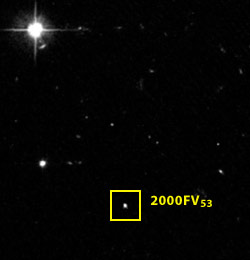
Astronomers used Kuiper Belt Object 2000 FV53 to guide the Hubble Space Telescope while searching for faint KBOs. The team found only three objects instead of the expected 85. Each of the discoveries is more than 100 times fainter than this KBO. Click on image for an animation.
Courtesy NASA and Gary Bernstein (University of Pennsylvania).
At face value this month's announcement of the dimmest object ever observed in the solar system seemed like yet another "farthest and faintest" record for the Hubble Space Telescope (HST). But the story behind the press release reveals much about the nature of the Kuiper Belt — the enigmatic outer debris left over from the formation of our solar system — and how it acts as a source for short-period comets.
At a meeting of planetary scientists in Monterey, California, Gary Bernstein (University of Pennsylvania) described how his team used HST's Advanced Camera for Surveys to search the icy region beyond Neptune. There they located three tiny objects, including 2003 BH91 observed at a distance of 6.4 billion kilometers (42.5 astronomical units). Its magnitude, 28.4, is 900 million times fainter than the dimmest stars humans can see with the unaided eye and corresponds to a diameter of about 25 kilometers. The two other objects, 2003 BF91 and 2003 BG91, were 40.2 a.u. and 42.1 a.u. away respectively, and are thought to be about 45 and 30 kilometers across.
The absence of more distant objects helps confirm that our solar system has an edge at around 50 a.u. — there are very few, if any, large objects beyond that point. The ACS survey was sensitive to Kuiper Belt objects (KBOs) as faint as magnitude 29.2, meaning that bodies 37 km across or larger were detectable as far as 60 a.u. away. If there were an even distribution of KBO sizes at all distances, ACS would have found some 85 new objects. But it found only three, each some 40 a.u. away.
Extrapolating the result of this survey (which covered about the size of Jupiter in the sky), "the total mass of the classical belt is about 4 Pluto masses [0.010 Earth masses]," says Bernstein. Until now, astronomers believed that the Kuiper Belt contained at least 0.03 Earth masses, likely more. "Perhaps we have discovered that the outer solar system has been destroying itself and only the biggest objects have survived."
Others at the Monterey meeting, however, had expected the result. In 1997 Paul R. Weissman (NASA/Jet Propulsion Laboratory) and Harold F. Levison (Southwest Research Institute, Boulder) predicted that there should be fewer KBOs than a simple extrapolation of sizes suggests. The number-versus-size distribution for KBOs, they postulated, would tail off in about the way that was observed. The fact that there are very few objects (if any) greater than 37 kilometers at the far reaches of the Kuiper Belt "doesn't come as a shock," says Levison. "We thought the break would be at 10 km. It turns out that its at 40 km."
Besides showing a dearth of Kuiper Belt objects, the ACS survey also gives some hint as to the origin of short-period comets. Dynamical simulations have shown that comets originate in the Kuiper Belt. But astronomers aren't sure how full the reservoir is. By finding no large objects at extreme distances, the ACS observations put a hard limit on the available large-nucleus comets (with diameters greater than 37 kilometers). However, Weissman says, the vast majority of measured short-period comets have diameters much smaller than that, on the order of 1–10 kilometers. So the true extent of the reservoir remains in question.
Bernstein says that to determine the supply of 10 km objects at 60 a.u., it would require observations down to magnitude 32 — far beyond the capabilities of current technology. A 1 km object at 40 a.u. would be around magnitude 35.
These results have been submitted to the Astrophysical Journal and are pending review.
 0
0
Comments
You must be logged in to post a comment.